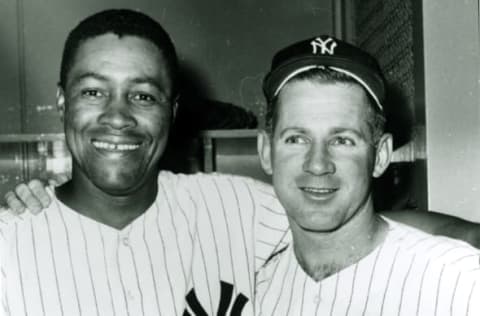Yankees History: Elston Howard outstanding catcher and trailblazer


Elston Howard had a distinguished career with the New York Yankees calling pitches and crushing the ball. While playing for the Yanks, he was an outstanding all-around catcher and helped them win critical games.
Howard was born in St. Louis, Missouri in February 1929. He was an elite athlete at Vashon High School. When he was 19 years old he turned down college football scholarships from three Big Ten powerhouses, the University of Illinois, the University of Michigan, and Michigan State University.
Ellie’s true passion as a young man was baseball. He rejected the football scholarship offers he received and, instead, signed to play professional baseball with the Kansas City Monarchs of the Negro American League. He roomed with Ernie Banks in 1950 and played outfield for three seasons with the Monarchs.
Seeing a lot of potential, the Bronx Bombers signed Howard in July 1950. The Yanks assigned him to the Muskegon Clippers, the team’s farm team in the Central League. Ellie missed the next two seasons due to his military service in the Army.
In 1953, he played for the Kansas City Blues of the Class AAA American Association. The next year the Yankees invited Howard to spring training and converted him into a catcher to back up the great Yogi Berra.
He played in the Class AAA International League in 1954. He performed extremely well and was chosen MVP of the league. The Yanks instructed Bill Dickey to work with Howard to perfect his catching skills and technique.
Ellie made the Yankees’ roster in 1955 and entered the second game of the regular season as a left fielder, the first time a black player had donned the pinstripes in the major league. As an unfortunate sign of the times, manager Casey Stengel called him “Eightball.” Stengel employed Ellie as a backup catcher and occasional outfielder. He hit .290 with 10 home runs and 43 RBIs during his first season with the club.
Backing up Berra for a few years during his prime prevented him from having more opportunities to shine, and the situation certainly depressed his numbers. If this was to occur today, Howard would be able to declare for free agency, join another team, and start behind the plate. This is exactly what Austin Romine chose to do during the offseason by signing with the Detroit Tigers. Free agency did not exist during the time Ellie played and was therefore not an option.

Howard played consistently well for the Bombers during his career. He was selected as the American League’s Most Valuable Player for the 1963 pennant-winning Yanks, becoming the first black player in AL history to win the award. During that year he led the league in slugging average (.528) and was fifth in home runs (28). He won Gold Glove Awards in 1963 and 1964, setting AL records for putouts and total chances in a season in 1964.
Ellie struggled in 1967 while backing up Jake Gibbs. He was traded to the Boston Red Sox in August of that year, and the Red Sox released him in 1968. He retired that year with a 27.1 WAR.
Ellie played in 12 All-Star Games and on four World Series championship teams, all with the Yanks. His lifetime fielding percentage of .993 as a catcher is impressive (obviously, Bill Dickey taught him well), and he retired among the AL career leaders in putouts and total chances.
Howard returned to the Bombers and was their first-base coach from 1969-1979. He was the first black coach in the American League, and he was a role model for black players. He then became an administrative assistant with the Yanks, but he had to relinquish the position due to poor health. Sadly, he passed away in 1980 from a heart ailment at the young age of 51.

In addition to becoming an outstanding receiver in MLB, Ellie also was a trailblazer. It was extremely difficult being a black man in the 1950s and 1960s and having to travel through certain parts of the country enduring insults, discrimination, and racism. Nevertheless, he bore the poor treatment and may have taken out his anger (assuming he had any) on the baseball diamond when he played.
He was extremely well respected by other players during his career. When he was with the Red Sox, Tony Conigliaro remarked, “I don’t think I ever saw a pitcher shake off one of his signs. They had too much respect for him.”
In July 1984 the Bombers retired Howard’s uniform number 32 and dedicated a plaque in his honor in Monument Park in Yankee Stadium. Ellie’s plaque describes him as “A man of great gentleness and dignity” and “one of the truly great Yankees.”
Next. Yankees History: Mickey Mantle an American Icon and Hero. dark
When one looks into the Yankees dugout today, it is hard to imagine that it was not that long ago that only white men played for the team. Howard and other black men made it possible for those of color to play the game, be respected and treated fairly, and be honored for their accomplishments.